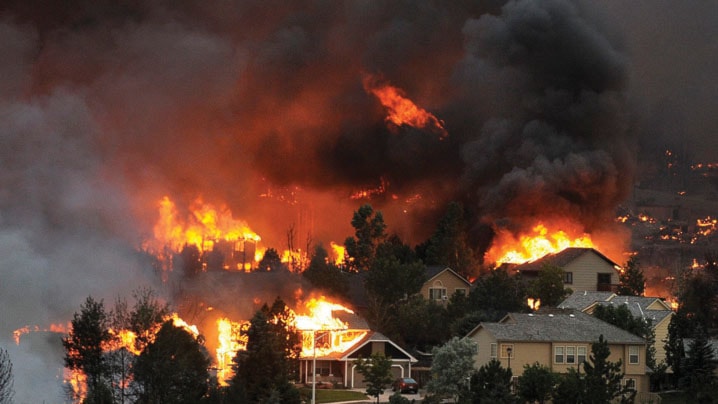WOODLAND PARK, Colo. — A towering wildfire jumped firefighters’ perimeter lines and moved into the city of Colorado Springs, forcing frantic evacuation orders for more than 32,000 residents, including the U.S. Air Force Academy, and destroying dozens of homes.
The fire doubled in size overnight to more than 24 square miles (62 square kilometres), fire information officer Rob Dyerberg said Wednesday. Authorities said it was too dangerous to fully assess its damage, and it was nowhere near contained.
“It was like looking at the worst movie set you could imagine,” Gov. John Hickenlooper said after flying over the fire late Tuesday. “It’s almost surreal.”
Heavy smoke and ash billowed from the foothills west of the city of 419,000 people as the Waldo Canyon Fire has become the top challenge for the nation’s firefighters.
Steve Cox, an aide to Mayor Steve Bach, said dozens of homes had been burned. Colorado Springs Fire Chief Richard Brown called the blaze “a firestorm of epic proportions.”
With flames cresting a ridge high above its campus, the Air Force Academy told more than 2,100 residents to evacuate. Elsewhere, fleeing residents covered their faces with T-shirts and bandanas to breathe through the smoke.
“People are freaking out,” Kathleen Tillman told The Denver Post. “You are driving through smoke. It is completely pitch black, and there is tons of ash dropping on the road.”
The fire is about 5 per cent contained, incident commander Rich Harvey said.
Christine Williams and her daughter Serina saw flames consuming grass just 30 yards (meters) from their apartment complex when they fled.
“It was pretty close,” Serina Williams said. “It was too close for comfort, that’s for sure. It’s like we’ve had our life swiped out from underneath us.”
Throughout the West, firefighters have toiled for days in searing, record-setting heat against fires fueled by prolonged drought. Most, if not all, of Utah, Colorado, Wyoming and Montana were under red flag warnings, meaning extreme fire danger.
The nation is experiencing “a super-heated spike on top of a decades-long warming trend,” said Derek Arndt, head of climate monitoring at the National Climatic Data Center.
In central Utah, authorities found one woman dead Tuesday when they returned to an evacuated area, marking the first casualty in a blaze that consumed at least two dozen homes. Sanpete County sheriff’s officials said they hadn’t identified the victim.
The cause of the Waldo Canyon fire remained under investigation.
In northern Colorado, another fire has destroyed 257 homes, authorities said. That fire was triggered by lightning June 9.
